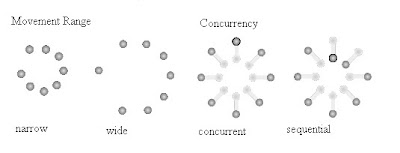Summary:
This paper described the research done by the authors involving the correlation between interactive attributes and emotional effects. The paper discussed testing different interactive methods that they believed were concrete and could be measured. The aim of their research as stated in the paper was to 'develop a set of attributes that works as a language to describe the shape of any interactivity of an interactive artifact.' The seven attributes that they believed could be described are displayed below, each with its opposing counterpart totaling to fourteen measurable attributes of interactivity.
- Concurrency (concurrent-sequential)
- Continuity (continuous-discrete)
- Expectedness (expected-unexpected)
- Movement range (narrow-wide)
- Movement speed (fast-slow)
- Proximity (precise-proximate)
- Response speed (delayed-prompt)

The research done also included a user study which tested the two main questions they were looking to answer:
- Are interactivity attributes perceivable as we perceive the attributes of physical materials?
- Do interactivity attributes have meaningful emotional effects as other physical materials have?
Discussion:
This paper was interesting in that it analyzed the emotions behind interactivity, concluding that there are concrete interactive attributes which can be used to describe the feelings felt when manipulating an interactive object and the perceived mapping that a user might use to compare the interaction to that of a material property. I liked the idea behind this paper, but I don't feel that they presented much evidence or even a very thorough principle. I believe that their conclusions were correct, but I think it really only scratched the surface of the topic and a further investigation is needed to really present a novel concept.

Here is a link that demonstrates the different interactive attributes:
ReplyDeletehttp://delivery.acm.org/10.1145/1520000/1518719/p105.mov?key1=1518719&key2=2555525621&coll=&dl=&CFID=76370824&CFTOKEN=64423921
Yeah, the idea of identifying the emotions to the shape of interaction was interesting, but I agree with you that it felt kind of like fluff. The testing wasn't terribly rigorous and they really just told me what I already knew.
ReplyDeleteThis paper sounds like preliminary research for something that society may one day find useful. The research itself, as mentioned above, really isn't all that useful on its own.
ReplyDelete